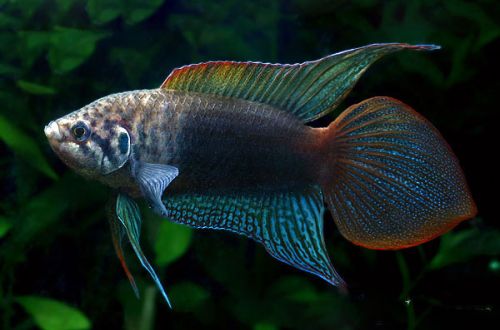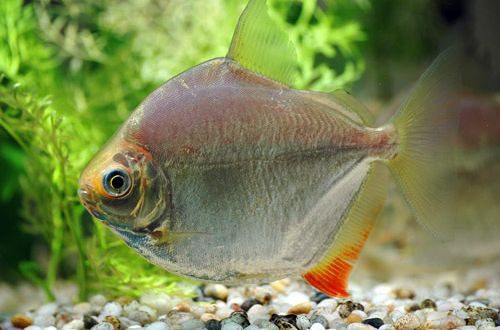
Macropod round-tailed
The round-tailed macropod or Chinese paradise fish, scientific name Macropodus ocellatus, belongs to the Osphronemidae family. A beautiful and extremely hardy fish that can successfully live even in an open pond in the summer. It does not tolerate water temperatures above 22 ° C and is unfriendly towards other species, all this greatly limits the circle of possible neighbors

Contents
Habitat
It originates from the territory of the Far East and Southeast Asia, but is found in modern China, Korea, Taiwan, Vietnam, as well as in the Amur River basin in Russia. It lives in backwaters of slow-flowing rivers, swamps, small streams and lakes with dense coastal vegetation. A characteristic feature of most of the habitat is seasonal temperature changes, during the winter months it drops to 3 ° C and the formation of ice on the surface of water bodies.
Brief information:
- The volume of the aquarium – from 80 liters.
- Temperature – 15-22°C
- Value pH — 6.0–7.5
- Water hardness – soft to hard (5-25 dGH)
- Substrate type – any
- Lighting – subdued
- Brackish water – no
- Water movement – little or no
- The size of the fish is up to 8 cm.
- Meals – any
- Temperament – unfriendly to other smaller species
- Keeping alone or in pairs male / female
Description
Adults reach a length of about 8 cm. The color is dark, the fins have a blue tint along the rays and a light edging. The caudal fin is large and rounded. Males are distinguished by enlarged fins and a more saturated color.
Food
The optimal diet consists of high-quality dry food with the addition of live or frozen foods (bloodworm, brine shrimp, daphnia). A varied diet has a positive effect on the tone and color of the fish.
Maintenance and care, arrangement of the aquarium
The volume of the tank for one pair of fish starts from 80 liters. The design uses dense thickets of shade-loving plants, including floating plants that can grow in cool water. The substrate is any dark, various shelters in the form of snags or decorative objects are placed at the bottom, for example, sunken ships, castles, etc.
Optimal water conditions are close to neutral pH with a wide range of hardness. The water temperature should not exceed 22 ° C, otherwise the fish becomes susceptible to various kinds of diseases. In this regard, there is no need to heat the aquarium, a filter and a low-power lighting system are sufficient from the equipment. The round-tailed macropod prefers subdued light to everything else. The tank is equipped with a special cover, usually supplied in the kit. It maintains a warm and moist air layer above the surface, necessary for the breathing of labyrinth fish, and also prevents accidental jumping out of the aquarium.
Behavior and Compatibility
A rather aggressive species, first of all, this applies to males who arrange serious skirmishes with each other for territory and females. In relation to other species, it is more restrained, but may pursue smaller individuals. It is recommended to keep as a harem, where there are several females per male, the company can be made up of several carp and goldfish of similar size.
Breeding / breeding
The round-tailed macropod is a close relative of the Classic Macropod (Macropodus opercularis) and can produce hybrid offspring with it, which are infertile. Therefore, refrain from keeping these two species together.
In view of the certain unpredictability of the male, in terms of behavior that can become overly aggressive during the mating season, spawning is recommended to be carried out in a separate tank. Usually a volume of 60 liters and a design in the form of a small cluster of floating plants is quite enough (hornwort is perfect). From the equipment you will need a heater, a simple airlift filter and a small lamp. A tight lid is a must.
The stimulus for spawning is a gradual increase in temperature in the general aquarium to 22–24°C and the inclusion of a large amount of live or frozen food in the diet. After a while, the male will start building a nest on the surface from bubbles and pieces of plants, at which point he should be transplanted into a separate tank filled with water from a common aquarium. Please note that the depth should not exceed 20 cm – imitation of shallow water. Females are not transplanted until the construction is completed, since during this period the male is aggressive even towards his future partners.
Spawning itself is accompanied by a kind of “embrace”, when the fish, the word, wrap around each other. At the point of climax, milt and a few eggs are released and then placed in the nest. This is repeated several times until all the eggs are released. Then the female is returned back. The male remains to protect the future offspring until it becomes free to swim, it takes about a week from the moment of spawning. On this, parental instincts disappear and the male begins to pose a threat to the fry.
Juveniles grow unevenly, some faster, others slower. As they mature, their behavior changes, smaller fish will be persecuted and some will be eaten. In the end, only the largest will survive.
Fish diseases
The main cause of most diseases is unsuitable living conditions and poor-quality food. If the first symptoms are detected, you should check the water parameters and the presence of high concentrations of hazardous substances (ammonia, nitrites, nitrates, etc.), if necessary, bring the indicators back to normal and only then proceed with treatment. Read more about symptoms and treatments in the Aquarium Fish Diseases section.





